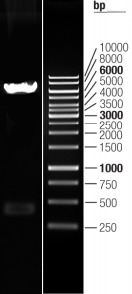TMEM100 (NM_018286) Human Tagged ORF Clone
CAT#: RC203980L1
- LentiORF®
Lenti ORF clone of Human transmembrane protein 100 (TMEM100), transcript variant 2, Myc-DDK-tagged
"NM_018286" in other vectors (6)
Specifications
| Product Data | |
| Type | Human Tagged ORF Clone |
| Tag | Myc-DDK |
| Symbol | TMEM100 |
| Synonyms | FLJ10970; FLJ37856 |
| Vector | pLenti-C-Myc-DDK |
| E. coli Selection | Chloramphenicol (34 ug/mL) |
| Mammalian Cell Selection | None |
| Sequence Data |
The ORF insert of this clone is exactly the same as(RC203980).
|
| Restriction Sites | SgfI-MluI Cloning Scheme for this gene |
| ACCN | NM_018286 |
| ORF Size | 402 bp |
| OTI Disclaimer | The molecular sequence of this clone aligns with the gene accession number as a point of reference only. However, individual transcript sequences of the same gene can differ through naturally occurring variations (e.g. polymorphisms), each with its own valid existence. This clone is substantially in agreement with the reference, but a complete review of all prevailing variants is recommended prior to use. More info |
| OTI Annotation | This clone was engineered to express the complete ORF with an expression tag. Expression varies depending on the nature of the gene. |
| Product Components | The ORF clone is ion-exchange column purified, transfection-ready dried plasmid DNA, and shipped with 2 vector sequencing primers. |
| Reconstitution | 1. Centrifuge at 5,000xg for 5min. 2. Carefully open the tube and add 100ul of sterile water to dissolve the DNA. 3. Close the tube and incubate for 10 minutes at room temperature. 4. Briefly vortex the tube and then do a quick spin (less than 5000xg) to concentrate the liquid at the bottom. 5. Store the suspended plasmid at -20°C. The DNA is stable for at least one year from date of shipping when stored at -20°C. |
| Reference Data | |
| RefSeq | NM_018286.1, NP_060756.1 |
| RefSeq Size | 1771 bp |
| RefSeq ORF | 405 bp |
| Locus ID | 55273 |
| UniProt ID | Q9NV29 |
| Cytogenetics | 17q22 |
| Protein Families | Transmembrane |
| MW | 14.4 kDa |
| Gene Summary | Plays a role during embryonic arterial endothelium differentiation and vascular morphogenesis through the ACVRL1 receptor-dependent signaling pathway upon stimulation by bone morphogenetic proteins, such as GDF2/BMP9 and BMP10. Involved in the regulation of nociception, acting as a modulator of the interaction between TRPA1 and TRPV1, two molecular sensors and mediators of pain signals in dorsal root ganglia (DRG) neurons. Mechanistically, it weakens their interaction, thereby releasing the inhibition of TRPA1 by TRPV1 and increasing the single-channel open probability of the TRPA1-TRPV1 complex. [UniProtKB/Swiss-Prot Function] |
Documents
| Product Manuals |
| FAQs |
Resources
Other Versions
| SKU | Description | Size | Price |
|---|---|---|---|
| SC113596 | TMEM100 (untagged)-Human transmembrane protein 100 (TMEM100), transcript variant 2 |
USD 310.00 |
|
| RC203980 | TMEM100 (Myc-DDK-tagged)-Human transmembrane protein 100 (TMEM100), transcript variant 2 |
USD 98.00 |
|
| RG203980 | TMEM100 (GFP-tagged) - Human transmembrane protein 100 (TMEM100), transcript variant 2 |
USD 460.00 |
|
| RC203980L2 | Lenti ORF clone of Human transmembrane protein 100 (TMEM100), transcript variant 2, mGFP tagged |
USD 620.00 |
|
| RC203980L3 | Lenti ORF clone of Human transmembrane protein 100 (TMEM100), transcript variant 2, Myc-DDK-tagged |
USD 620.00 |
|
| RC203980L4 | Lenti ORF clone of Human transmembrane protein 100 (TMEM100), transcript variant 2, mGFP tagged |
USD 620.00 |
{0} Product Review(s)
Be the first one to submit a review






























































































































































































































































 Germany
Germany
 Japan
Japan
 United Kingdom
United Kingdom
 China
China


